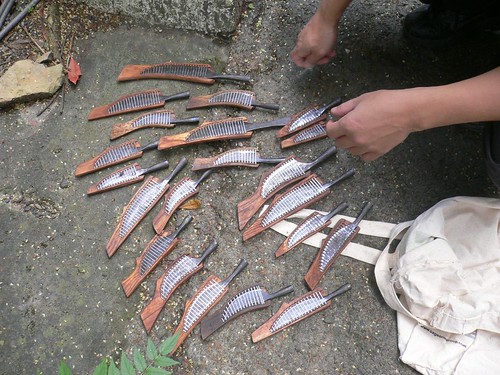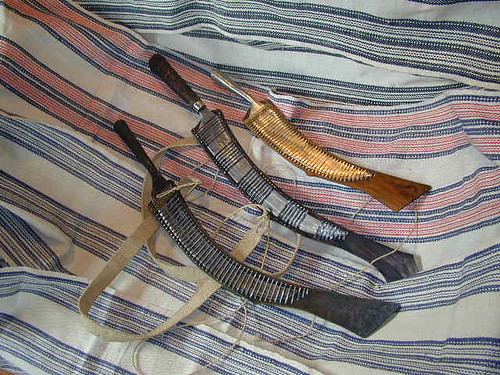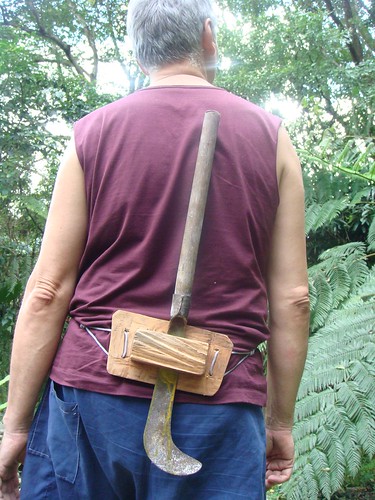
 |
|
|
|
|
#1 |
|
Member
Join Date: Dec 2004
Location: What is still UK
Posts: 5,925
|
Yes great interest. I might add that Nicolas is now the owner of the example I had.
|
|
|

|
|
|
#2 | ||
|
Member
Join Date: Oct 2008
Location: between work and sleep
Posts: 731
|
Quote:
Quote:
Lucky Nicholas, authentic Taiwanese aboriginal pieces are rare, I hope he treasures it forever... if not he should hit me up with a message  hahaha, but I have no doubt he will hahaha, but I have no doubt he will
Last edited by KuKulzA28; 10th August 2009 at 11:57 PM. |
||
|
|

|
|
|
#3 |
|
Member
Join Date: Oct 2008
Location: between work and sleep
Posts: 731
|
More on modern-made Taiwanese Aborigine (原住民) blades... I am surprised at how helpful some folks are... when the person contacting them in far away and may never meet them face to face. I am trying to figure out the general location of the few aboriginal or sino-aboriginal blade-makers left.... so far I am having more success with the Atayal, perhaps because I am more interested in their blades or perhaps because their blade making and usage is more intact... not sure.
If Yuanzhumin (anglicized for 原住民) was around more I'm sure he'd be way more helpful! EDIT: Yuanzhumin if you're reading this stuff, please feel free to chime in. I take no credit for these photos, they belong to their owners, posted on flickr Yugan Dali's photos on flickr. These are puli (bulee) and laraw (la-row).   fm4715/魯獅's photo on flickr. I do not recognize who makes these Laraw.  Kimisibal's photo on flickr... looks to be from Hualien but I am not sure. 
Last edited by KuKulzA28; 4th September 2009 at 02:02 AM. |
|
|

|
|
|
#4 |
|
Member
Join Date: Oct 2008
Location: between work and sleep
Posts: 731
|
In addition to those above, I am trying to trace the origins of these, which may be tourist blades
 : :  These seem to be the 銅門, Hualien made Aboriginal blades mixed with some sickle-like 開山刀 in the mix. It would seem the Aboriginal blades give a good account of themselves as "machetes". I myself have tested mine out - not bad! Most Han Taiwanese use 開山刀 for brush clearing like a machete. It is also commonly used in Guangdong and Fujian where the handcrafts of making such tools is also dying... ironically while the villagers in both areas prefer the well-made, quality tools of old master craftsmen... very few young apprentices are to be found.  On the side... Yugan Dali's photo on flickr showing one way to wear a sickle-開山刀 
Last edited by KuKulzA28; 4th September 2009 at 05:02 AM. |
|
|

|
|
|
#5 |
|
Member
Join Date: Oct 2008
Location: between work and sleep
Posts: 731
|
For those interested...
this Taiwanese aboriginal blade looks like a single butterfly sword's blade with a typical aboriginal metal socket handle. It is sheathed in the Aboriginal way. I want to say it is from one of the western plains groups, and had a lot of Chinese influence... but I am no expert.  One of freebooter's butterfly swords for reference: [from freebooter's Swords & Antiques Gallery]  
Last edited by KuKulzA28; 4th January 2010 at 10:37 PM. |
|
|

|
|
|
#6 |
|
Member
Join Date: Oct 2007
Posts: 2,818
|
A very interesting similarity. The tribal piece you present almosts looks as though it could have once been a pole arm blade with the metal sleeve shortened as the polearms of this type were common amongst the Tiger troops of China and I am sure others too. There have been a number of historical images showing this.
Best Gav. |
|
|

|
|
|
#7 | |
|
Member
Join Date: Oct 2008
Location: between work and sleep
Posts: 731
|
Quote:
I am not sure which is more likely... [1] Shortened Chinese polearm blade [2] Aboriginal/Chinese smith copying Southern Chinese blade design More research will have to be done on the blade style and the sheath, but it is hard to say whether the Aborigines forged certain style blades for themselves, or had others forge certain style blades for them... because all of the tribal groups have relatively distinct blades. The Atayal in the north has characteristically curved blades. The Amis and Paiwan in the Southeast have straight blades. The others have blades everywhere in between. Tribes from the western plains, now mainly mixed into the Hoklo and Hakka population, had the most Chinese influence. Their blades were often re-used Chinese blades, or in that style. The Asian Ethnographic Collection of the Division of Anthropology in the American Museum of Natural History says little about the aforementioned blade that could be helpful. Here's one from the Yang Grevot Collection. While Ping Pu artifacts are rare, they all seem to know certain similarities to Chinese blades.  Notice this one looks almost exactly like a Hu-dieh-dao blade and have a two-sided sheath, not an open-faced one as is popular with almost all Taiwanese aborigines. The person who wrote the caption for it said: "Closely resembling Atayal and Amis knives in form, this knife also has clear Chinese characteristics and was fashioned in a transitional style typical of the Pingpu, the Austronesian people from the island's plains who were influenced by early Chinese immigrants. With time, the Pingpu were assimilated into the Taiwanese population, in contrast to the aboriginal peoples of the highlands, who continue to form a distinct indigenous group to this day."While I can see the similarity to Amis knives, Atayal knives (pre-Japanese contact) have characteristic curve to them. Here's something else. As a Taiwanese American knife aficionado, I've been browsing Taiwanese cutlery sites. Here's one with 2 blades that might be worth considering. If you link on the link, go to the third button down and click it, these two blades should show up further down the page.   They are the: "江南板刀" and the "江南刁刀" Means something like "River-South-Plank-Knife" and "River-South-Wicked-Knife" Notice how similar their handles are to the PingPu (plains) knife of the Yang-Grevot collection. Notice how the blade style is related to both the Museum and the Collection's two knives above... and the coastal regiosn south of the "river" (Yangtze) is Zheijiang, Fujian, and Guangdong. Precisely our target demographic when talking about Chinese immigration to Taiwan in this time period. Their descriptions read something like this... (my Chinese isn't great so I am using what I know + online translators) [1]This knife style forms a straight line with the hilt and back of the blade (hence plank). It is mainly used the in the area south of the Yangtze River. In ancient times, Tangshan people relocated to reclaim wasteland Taiwan. This is a convenient blade for a long journey because it can do work and be fought with. The knife is made according to its use/goal. In fables, the righteous thief Liao Tianding (Taiwanese Robin Hood) uses a "short plank" like this for self defense. This knife has brass button decoration which improves grip and artistry. The scabbard is made after a careful design and doesn't loosen.If only to make it more interesting and more factors... now there is this as a possible influence. Not only could this have been a shortened polearm or a locally made blade design... it could also come from or be heavily influenced by the South-River-Knife style...   
|
|
|
|

|
 |
|
|